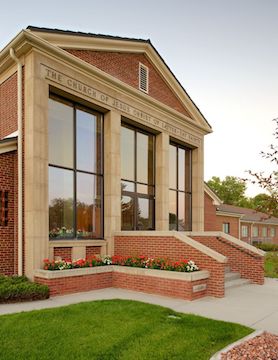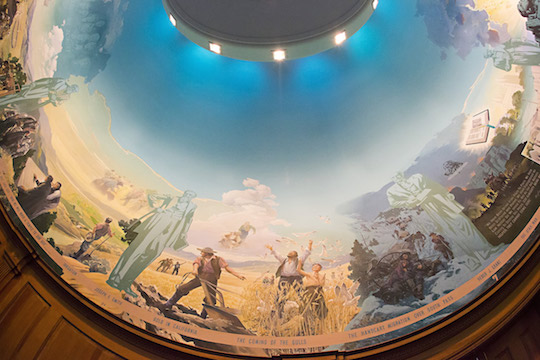Historic Cody Mural and Museum
The Historic Cody Mural and Museum, located in Cody, Wyoming, is a contemporary meetinghouse of The Church of Jesus Christ of Latter-day Saints that features a large domed ceiling with a mural depicting scenes from the history of the Church. It offers a compelling glimpse into the western expansion of Mormon pioneers in the late 1800s.
Contents
History
Glenn E. Nielson, a local businessman and active member of the Church of Jesus Christ, originally proposed that church bells be installed in the building. The bells would play hymns to be enjoyed by those living near the building. However, a chance meeting with Elder Henry D. Moyle on a trip to San Francisco changed his plan. Instead of bells playing hymns, Moyle suggested that a painting reflecting the Mormon pioneer experience be created.
Returning to Cody, Nielson met with Chicago artist Edward T. Grigware, who had relocated to Wyoming in the 1930s. Grigware noted the size and shape of the rotunda and space and asked that instead of a mere painting, he be allowed to create a mural.
The Mural
Grigware, who was not a Latter-day Saint himself, spent a year researching and understanding the history of the Church, which gave him a respect and love for the early members of the Church. The mural depicts several important scenes in the Restoration, including Joseph Smith receiving the golden plates from which he translated the Book of Mormon, the martyrdom of Joseph and Hyrum Smith, and the pioneers trekking to the Salt Lake Valley and building a temple where they could worship God. Portraits of the first eight Presidents of the Church are interspersed among depictions of these stories. The mural took nearly two years to complete. Grigware’s technical expertise in Western realistic painting, as well as the mural’s one-of-a-kind medium and location create a fascinating work of art and an intricate storytelling device.
The Museum
In addition to the magnificent mural, museum exhibits include original works by local artists as well as commissioned art pieces. The museum also displays historic artifacts, including a first-edition Book of Mormon (only 5,000 copies were part of that first printing). Visitors will also see a seven-minute video and explore touch-screen displays. The settling of the Big Horn Basin and building of the Sidon Canal is included in the museum experience. Interactive kiosks are also available for guests to explore their family histories. One of the kiosks provides access to a popular family search program that helps people find out more about their relatives, specifically those in the Bighorn Basin.
The Chapel
Elder Henry D. Moyle first dedicated the chapel in 1949. Since then, the building has been renovated several times and the original mural preserved. In 1972 Elder Hugh B. Brown rededicated the chapel. Visitors can take free guided tours during the summer.

